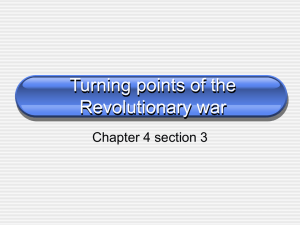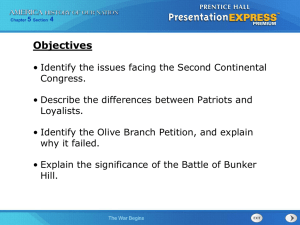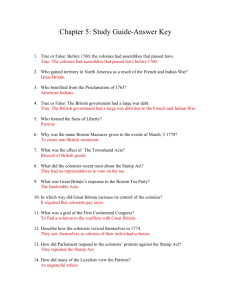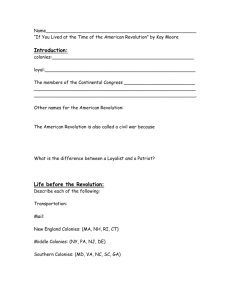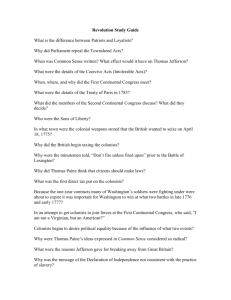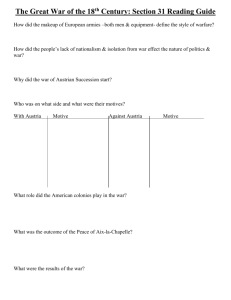Road to Independence
advertisement
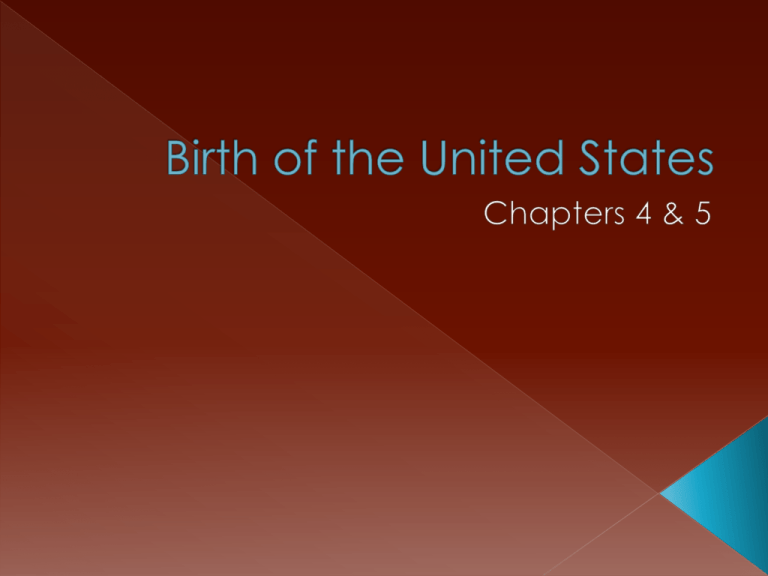
Chapter 4 Causes of War › Rivalry Between Britain and France French had more land British along coast, French Inland B = farm, F = trapping French better with NAs June 1754 – delegates to Albany To strengthen ties with NAs Unify war effort Ben Franklin wanted a permanent union Plan was a grand council of elected delegates fro each colony run by a president Similar to Iroquois League Approved but colonies rejected Didn’t want a central government British lost at beginning 1735 – 900 F and NA attacked Militia – armed citizens who served as soldiers British – open areas and straight lines F and NA – hiding and spread out 1756 – Britain declares war on France William Pitt = British Prime Minister Raised taxes and borrowed money to fight British now better prepared Won several major battles French retreated 1763 – Great Britain, France, Spain met in Paris Ended French and Indian War and Seven Years’ War (Europe) French lost everything English got Canada, all land west of Mississippi Spain got Cuba for Florida Thought colonies didn’t help enough Colonists would have fought under other colonists rather than British officers Considered treasonous Loss of respect for British military Colonists not getting enough respect Thought they should be on their own › Changing British Policy Proclamation of 1763 NA worried about British farmers destroyed land Unlike French British hated NAs Stopped dealing with them King George closed area west of colonies 1764-1766 Peace treaties with tribes Colonists continued to settle Cut duty on foreign molasses in half Raised the tax Hoped people would buy foreign molasses and pay tax rather than smuggle Enforcement Ships could be seized if though smuggling Judges got 5% commission if ship found guilty Colonies had to provide shelter and food for British soldiers Colonists very angry but went along What is the Stamp Act? Stamp Act – tax on anything on paper Royal stamp to prove tax paid Outrage was widespread and extreme Affected everyone October 1765 Delegates from 9 colonies met in New York Leader – James Otis, lawyer from Massachusetts Taxation without representation Sent petitions to the king about rights Boycott of British goods Boycott – refusal to buy certain products as act of protest Groups known as Sons and Daughters of Liberty Founder – Samuel Adams Went to stamp distributers homes – resign or house burned Eventually no one left to sell stamps 1766 – Act was repealed 1767 –Put duty on things like glass and tea New finance minister Charles Townshend Raised duties rather than taxes = safer Colonists still upset about taxes with no rep. Boycott again British troops sent to deal with violence in Boston March 5, 1770 Small crowd threw snowballs at troops Troops killed 5 Crispus Attucks – 1st African American to die in Rev. Next day, 9 British charged with murder John Adams defended them 7 found not guilty, 2 guilty of lesser crimes Punishment – Branded thumbs Parliament cancelled Townshend Act but kept tea tax May 1773 – Tea Act to help British East India Company BEIC didn’t have to pay taxes Made it cheaper than smuggled tea Some harbors wouldn’t let ships in December 16, 1773 Colonists disguised as Indians boarded three ships Broke open every crate and threw in the water Spring 1774 – punishment for Tea Party Harsh laws that were ridiculous Limited town meetings to once a year Colonies called for group of people to fight back First Continental Congress formed September 5, 1774 56 delegates in Philadelphia Founder Fathers Renewed boycotts and create militias Direct appeal to King Left October 26, met again in spring if issues not resolved Groups of fighters called Patriots Massachusetts Militia created stockpile of weapons in Concord April 18, 1775, British marched to get supply Patriots found out and Paul Revere and two other rode to tell THE BRITISH ARE COMING In Lexington, fighting took minutes, 18 Americans dead or wounded Destroyed some of supply in Concord, left for Boston 4000 Patriots stood in their way Shot at them from behind walls and buildings 240 British killed/wounded Became first battle of Revolutionary War The Delegates Second Continental Congress met in May 1776 Ben Franklin, Thomas Jefferson, John Hancock Divided between solution and independence Olive Branch Petition Wanted Peaceful solution End fighting and stay loyal to Britain Denied June 1776 – wrote Declaration of Independence Thomas Jefferson wrote most the document List of reasons for leaving and why Jefferson influenced by the Enlightenment of 1700s Science and Reason were keys to improved society Used John Locke’s ideas for government July 4, 1776 Delegates approved Declaration The Siege of Boston › Patriots surrounded Boston for protection Others attacked British forts to get supplies General Thomas Gage in charge of British forces June 17, 1775 – Gage wants hills for lookouts Attacked in tight blocks, easy target for muskets Retreated and attacked again, retreated, attacked a 3rd time Able to take Breed’s Hill b/c Patriots ran out of ammo Forced Patriots off Bunker Hill as well Half of British 2400 died, only 400 Patriots July 1775 – George Washington put in charge of newly named Continental Army January 1776 – Gen Knox brought cannons to south of Boston Fired on British and their ships in the harbor British flee with 1000 loyalists (people still devout to England) The British Well equipped, disciplined and trained Supported by best navy in the world Loyalists and some NAs helped fight Hired 30000 mercenaries to fight Mercenary – paid foreign soldiers Called Hessians (German) Problem – war not popular in England Citizens resented the taxes Troops had to fight in hostile territory Fighting on their own territory Officers familiar with successful fighting tactics Lacked equipment and stable fighting force British won many battles Washington wanted a spy Nathan Hale crossed lines and got information Caught before he could give information Hung – Famous Last words “I regret that I have but one life to give for my country.” British took NY, pushed Patriots to Penn. Troops deserted and Washington thought army was falling apart Thomas Paine wrote “The Crisis” to get people back on board Washington had to be creative due to lack of everything Fought during winter Battle of Trenton – crossed Delaware River and captured entire Hessian force Did same thing at Princeton British Gen. Cornwallis saw troops coming but were pushed back Patriot morale went up due to wins Had no money and couldn’t require taxes since their was not yet a government Asked for help from colonies Issued paper money to buy supplies Nothing to back it up, if lost – money was worthless Fighting in the West Col. George Rogers Clark fought and won in IN/IL Claimed the Ohio River for Patriots Fighting in the South Worst fighting happened in South Loyalist vs. Patriots Several battles lead by British Gen Cornwallis Retreated to Yorktown on a peninsula Patriots blocked way out French and Continental Army combined Bombarded Yorktown with ammunition Escape was impossible Cornwallis surrenders on October 19, 1781 England, France, Spain, US 1783 US becomes independent Canadian boarder set Mississippi sets boarder between colonies and Spanish territory Florida given back to Spain England removes all troops Pledged to not harm any Loyalists (did anyway!) Chapter 5 People believed they were citizens of states – not a country Did not want a central government 1777 – Continental Congress adopted the articles Approved in 1781 Established a limited national government Most power lay with the states One branch – legislative (Congress) Congress did job of all three branches (Executive/Judicial) States maintained own courts As many delegates as state wanted but only one vote Laws required 9 of 13 to pass Economic Problems Wealthy worried too much power for people 1786 – National Debt $50 million Printed more money with no backing Each state had own money States taxed each other 1780s = Nationalist immerged wanted to strengthen national government Washington, Madison, Hamilton Needed strong government and courts People didn’t agree Thought articles were doing their job Learning from History Men were well educated Knew European countries had tried and failed Annapolis Convention 1786 – Nationalist Convention Plan to regulate interstate and foreign trade Did not address AOC weaknesses 12 men from five states Set up 1787 convention in Philadelphia People who gave money for war wanted it back Mass. – heavies direct tax had to be paid in specie Specie – gold or sliver coin Farmers couldn’t afford it and complained State refused to repeal Daniel Shay, war vet and farmer 1786- lead rebellion to tax Drove off collectors, protested, riots State had no money to fight them until 1787 Rebels left for Vermont or NY Shay and others were caught, but freed eventually People determination against authority Need to strengthen national government to avoid civil unrest › Convention Assembles Constitutional Convention – meeting of May 1787 In Philadelphia 55 delegates from all but Rhode Island Ages 27-81, rich to middle class James Madison (36) Attended every meeting and took notes Spent year before learning history, law, government Drew on Enlightenment thinkers Believed a Constitution was best › Division at the Convention 1st act – George Washington elected president of convention Unanimous vote Divided – amend AOC or new document Bicameral – two houses Representation – by population or financial support Representatives Lower house – popular vote Upper House – nominated Popular among larger state One house Representation – equal for each state Representatives – elected by state legislature Popular among little states The Great Compromise Introduced by Connecticut Took from both Bicameral Representation Two houses Senate – two regardless of size House of Representatives – based on population Approved on July 16th, 1787 Dealt with slavery Southern states wanted to use slaves for representation numbers Northern states with few slaves didn’t like this Formula made for population count Three fifths compromise – 3 of 5 slaves would count toward population Didn’t let slaves vote or have rights (NA too) Final draft approves September 17, 1787 Hasn’t changed much in 200 years Specific but flexible Only 27 changes (Amendments) › The Federalist View To become law, 9 of 13 had to ratify Ratify - approve Those who favored called Federalists Wrote “The Federalist Papers” 85 essays supporting Explains the new government and why each part is good Federal government was only slightly more powerful than states People who opposed Constitution Posed a threat to state and individual rights Seen as a betrayal of the Revolution Federal Government was going to rule peoples lives Uneasy about taxes Feared loss of liberty again Submitted on September 28, 1787 Federalists campaigned to get Constitution ratified Drew on idea that the AOC had many problems All Federalists were behind the Constitution, AFs didn’t have plan Well organized and communicated George Washington was Federalist Everyone expected him to be the first president Good leader, intelligent, gave up army voluntarily Small states ratified first – most to gain May 1790 – Rhode Island – last of 13 to ratify Protecting Individual Rights Clear declaration of rights September 1789 – James Madison offers BOR Took effect December 15, 1791 1 Freedom of religion, speech, press, assembly & petition 2 Right to bear arms 3 No quartering of soldiers in private homes 4 No unreasonable search and seizure 5 Double Jeopardy, Taking of private land, Selfincrimination 6 Fair and speedy trial 7 Right to a jury trial 8 No cruel and unusual punishment and excessive bail 9 People have more rights than the ones listed 10 Power not given to the Federal government go to state or people Against the Bill of Rights Federalist saw no need for these Saw it unnecessary to state these rights “people surrender nothing” For the Bill of Rights Anti-federalist needed clarification Used to restrain the Federal government Jefferson wanted a list of “unalienable rights” Wanted clear, detailed language Compromise worked, passed The New Leaders April 30, 1789 – Washington inaugurated Inauguration – Official swearing in Won in unanimous vote John Adams – vice president Started choose cabinet (Leaders of major departments) Had been Governor of Virginia and Ambassador to France Became involved in Domestic affairs Federalist with liberal views Well educated and sense of duty made him good politician Choose because he knew France well and was trusted Well educated, leader in army Headed largest department of federal government Believed the government could accomplish anything Things went smoothly for first few years Economy got better Large and small problems faced by Washington Set many precedents Example: Mr. President Office was made for him Was surrounded by much ceremony Won reelection – 2nd term was very hard Set the standard for presidency New York and Philadelphia served as capitals Residence Act of 1790 set aside 10 square mile area Between Maryland and Virginia – not in a state Run by the Federal Government Benjamin Banneker (AA mathematician and inventor) and Pierre-Charles L’Enfant (French artist) Created plans for buildings, White House, Capital, streets and parks Originally District of Columbia Added Washington after GW died in 1799

